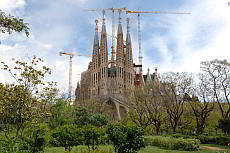Jardí Botànic - the botanical garden
Plants of the Mediterranean climate zones around the world
In the Jardí Botànic, Barcelona's botanical garden with a total size of 14 hectares, you can see the typical vegetation of six different zones with Mediterranean climate and the Canary Islands. The beautiful park between the Castell de Montjüic and the Olympic stadium comprises typical forests and shrubs from southern Australia, South Africa, Chile, California, the Canary Island and the three Mediterranean zones.
The botanical garden covers more than 14 hectares and is one of the largest parks in Barcelona. From here, you have a wonderful view of the Llobregat Delta, the urban area of Barcelona, the freight port and the Olympic sports venues on the Montjuïc.
The botanical garden features a representative selection of the flora in regions with Mediterranean climate all around the world. The Mediterranean climate is characterized by dry, hot summers. The rain mainly falls in winter, which is why it is also called winter rain climate. This climate zone is not exclusively found in the Mediterranean area, but also in other regions roughly at the same latitude as the Mediterranean area.
The vegetation in the areas with Mediterranean climate is mostly characterized by sclerophyllous plants like the olive tree, a typical Mediterranean plant.
Visiting the Jardí Botànic
The aim of the park, which opened in 1999, is among other things the conservation of rare plant species. About 1 500 plant species grow in the Jardí Botànic. Since the park is still quite new, most of the plants are relatively young. Some areas have not yet been planted in order to maintain a mixture of old and young plants. Still, the park is very pretty and there is a lot to be discovered.
The park was laid out by an interdisciplinary team led by the architect Carles Ferrater. In the Institute of Botany within the compound of the garden, there are changing exhibitions related to botany on display.
Mediterranean zones represented at the botanical garden
The Mediterranean climate in Southern Australia
The Mediterranean zone of Australia is the second largest one after the Mediterranean itself. It consists of two sectors in southern and southwestern Australia. In this climate zone, some 8,000 endemic plant species are known, 75 % of which are wide-spread, the remaining 25 % grow sporadically. The climate with monsoon rains is influenced by the tropics.
Cooler Mediterranean climate along the coast of Chile
In Chile, a narrow zone along the coast has Mediterranean climate. Since it is close to the Pacific Ocean, it is a little cooler and often there are foggy conditions near the coast. There are 2,400 endemic species here, 23 % of them are wide-spread. Characteristic plants along the coast are shrubs that are little fire-resistant as natural fires hardly ever occur in the Chilean Mediterranean zone.
California and its climate with stark contrasts
California's coastal sector with winter rain climate is 100 to 2000 m wide and extends from Cape Blanco in the USA to Punta Baja in Mexico. San Francisco is the zone's centre. There are 43,000 known endemic species, 25 % of which are wide-spread. The Californian climate is distinctively Mediterranean. Around 85 % of the rain falls in winter so that it is very dry in summer. Plants like the yucca palm are adapted to the dry periods in summer and can store water for a long period of time.
Equal precipitations all year long in South Africa
The smallest zone with Mediterranean climate is South Africa with 8,500 known species. Since natural fires occur regularly, a large number of species (85 %) is wide-spread.
It mainly rains in winter, but due to the monsoon, it is never entirely dry in summer either. The vegetation in South Africa mainly consists of shrubs and bushes.
The Mediterranean Basin
The land around the Mediterranean is referred to as the Mediterranean Basin. Altogether, there are more than 25,000 endemic species originating in Europe, Asia and Africa, 50 % of which are wide-spread. The plants, strong trees, shrubs and bushes, have developed remarkable regenerative abilities. They resist fire or regenerate quickly after fire, storm and extreme drought.
Free admission with the Barcelona Card
(Click on the product images to view prices and availability)
- Free use of public transportation
- Many free and discounted entries to attractions
- Barcelona Card: free entry to the Botanical Garden
- Barcelona Card Express: 50% discount to the Botanical Garden
Important information
Surroundings
Find Hotels nearby
Address
Phone: +34 932 564 160
link.bcn.cat/cJB
Arrival
Metro: Espanya (L1, L3)
Bus Turístic: Fundacio Joan Miró (dann 400 Meter zu Fuß)
Parking nearby
Opening times
October to March: Monday to Sunday, from 10 to 18 h
April, May and September: Monday to Sunday, from 10 to 19 h
June, July and August: Monday to Sunday, 10 to 20 h
Closed
January 1st, May 1st, June 24th and December 25th
Free admission on special days:
Every Sunday from 15 h and the first Sunday of every month
February 12nd, May 18th, September 24th
Tips for the visit of the Jardí Botànic
There are offered some guides tours. You can learn many about the plants and their survival strategies. Information on the website of the garden.
Book your accommodation in Barcelona here! All categories.
1-5*-hotel rooms, apartments, hostels.










